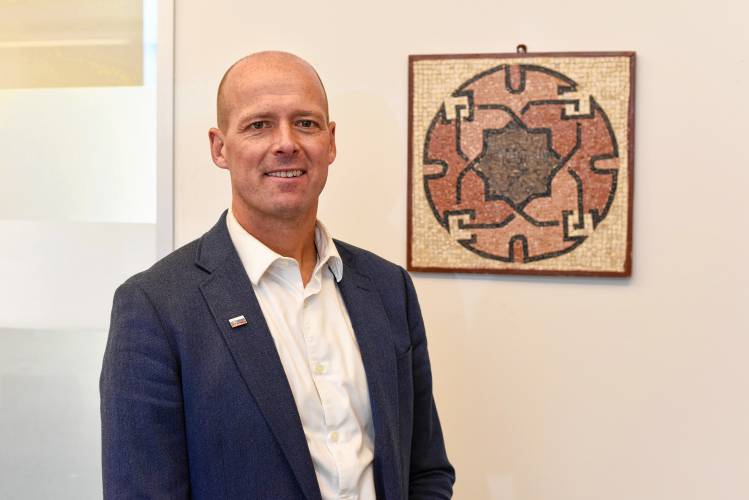Faith Matters: The key and the horn: In uncertain and unstable times, hope for the future is what unites us

Dean of Spiritual and Ethical Life at Deerfield Academy, Jan Flaska, next to a Jordanian mosaic from Madaba that hangs in the school’s library. STAFF PHOTO/PAUL FRANZ
| Published: 10-27-2023 10:14 AM |
In 2012, while on a family visit to Oaxaca, Mexico, the ground beneath me started to move. A disconcerting experience, for certain.
In just a few seconds, my mother and I recognized this for what it was: an earthquake. We instantly ran from the room and into a courtyard, where the ground beneath us quivered and waves were observed in the swimming pool. The land beneath our feet was uncertain and unstable. What was familiar and steady was now foreign and fleeting. For me, from a distance, I see this event in my life as representative of the conundrum and volatility of the lands of Israel and Palestine.
At its essence, the shared interest of these two nations and ethnicities is this: the ensnared complications of securing a homeland. Israeli Jews and Muslim Palestinians are daughters of Eve and sons of Adam, descendants of Abraham, and, collectively, and certainly more broadly, people of the Book, those who see revelation historically and see their lives as blessed in the figurative eyes of Yahweh or Allah. Yet, the proprietorship and stewardship of the land remains unstable and uncertain. An oversimplification, yet a patent truism, is this: it’s complicated.
Metaphors make meaning by naming the unnameable. The key, for Palestinians, and the horn, for Jewish Israelis, offer the story, the spirit, the synergism leading to a future peace. Worn as a pendant on a necklace, the key, for many Palestinians, symbolizes hope - a return to familiarity, a return to neighborhoods disturbed and destroyed, and a return to land that is a source of agricultural and ancestral hope. The horn, a Jewish shofar — a ram’s horn — is sounded on the Jewish New Year to announce an optimism of what lies ahead. For them, the future, in relationship with the Creator and creation, must be bright, accessible and secured. An amalgamation of these two objects, the key and the horn, speaks to the shared vision that all parties seek: Hope for the Future.
Events across the globe fracture this hope and compromise our collective future. Though an epicenter may be located in Gaza, the tremors are felt far and wide, under the feet of stakeholders and spectators alike. No one wants a world that is chaotic and disjointed.
Order and harmony ensure collaboration, prosperity and self and collective worth. The key, whose origins are 75 years old, and the horn, who origins are ancient, through the wisdom of generations, desperately ask us to lean toward compassion.
The past cannot be changed; the future must.
Jan Flaska is the Dean of Spiritual and Ethical Life at Deerfield Academy. Importantly, in that capacity at Deerfield Academy, a school of 650 students with residential and commuter students attending grades 9-12, Jan seeks insight and feedback from the Deerfield Academy Student Spiritual Council, a group of students that join Jan to support the spiritual needs and curiosities of the students and the greater Deerfield Academy community. Jan Flaska can be contacted at jflaska@deerfield.edu.
Article continues after...
Yesterday's Most Read Articles

 Speaking of Nature: Indulging in eye candy: Finally, after such a long wait, it’s beginning to look like spring is here
Speaking of Nature: Indulging in eye candy: Finally, after such a long wait, it’s beginning to look like spring is here Celebrating ‘Seasonings’: New book by veteran preacher and poet, Allen ‘Mick’ Comstock
Celebrating ‘Seasonings’: New book by veteran preacher and poet, Allen ‘Mick’ Comstock Faith Matters: How to still the muddy waters of overthinking: Clarity, peace and God can be found in the quiet spaces
Faith Matters: How to still the muddy waters of overthinking: Clarity, peace and God can be found in the quiet spaces A time for every purpose under heaven: Free sing-a-long Pete Seeger Fest returns to Ashfield, April 6
A time for every purpose under heaven: Free sing-a-long Pete Seeger Fest returns to Ashfield, April 6
